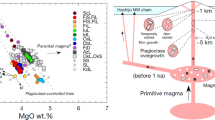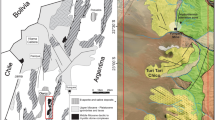Abstract
Quaternary basalts, andesites and dacites from the Abu monogenetic volcano group, SW Japan, (composed of more than 40 monogenetic volcanoes) show two distinct chemical trends especially on the FeO*/MgO vs SiO2 diagram. One trend is characterized by FeO*/MgO-enrichment with a slight increase in SiO2 content (Fe-type trend), whereas the other shows a marked SiO2-enrichment with relatively constant FeO*/MgO ratios (Si-type trend). The Fe-type trend is explained by fractional crystallization with subtraction of olivine and augite from a primitive alkali basalt magma. Rocks of the Si-type trend are characterized by partially melted or resorbed quartz and sodic plagioclase phenocrysts and/or fine-grained basaltic inclusions. They are most likely products of mixing of a primitive alkali basalt magma containing olivine phenocrysts with a dacite magma containing quartz, sodic plagioclase and hornblende phenocrysts. Petrographic variation as well as chemical variation from basalt to dacite of the Si-type trend is accounted for by various mixing ratios of basalt and dacite magmas. Pargasitic hornblende and clinopyroxene phenocrysts in andesite and dacite may have crystallized from basaltic magma during magma mixing. Olivine and spinel, and quartz, sodic plagioclase and common hornblende had crystallized in basaltic and dacitic magmas, respectively, before the mixing. Within a lava flow, the abundance of basaltic inclusions decreases from the area near the eruptive vent towards the perimeter of the flow, and the number of resorbed phenocrysts varies inversely, suggesting zonation in the magma chamber.
The mode of mixing changes depending on the mixing ratio. In the mafic mixture, basalt and dacite magmas can mix in the liquid state (liquid-liquid mixing). In the silicic mixture, on the other hand, the basalt magma was quenched and formed inclusions (liquid-solid mixing). During mixing, the disaggregated basalt magma and the host dacite magma soon reached thermal equilibrium. Compositional homogenization of the mixed magma can occur only when the equilibrium temperature is sufficiently above the solidus of the basalt magma. The Si-type trend is chemically and petrographically similar to the calc-alkalic trend. Therefore, a calc-alkalic trend which is distinguished from a fractional crystallization trend (e.g. Fe-type trend) may be a product of magma mixing.
Similar content being viewed by others
References
Anderson AT (1976) Magma mixing: Petrological process and volcanological tool. J Volcanol Geotherm Res 1:3–33
Bacon CR, Metz J (1984) Magmatic inclusions in rhyelites, contaminated basalts, and compositional zonation beneath the Coso volcanic field, California. Contrib Mineral Petrol 85:346–365
Bence AE, Albee AL (1968) Empirical correction factors for the electron microanalysis of silicates and oxides. J Geol 76:382–403
Blake DH, Elwell RWD, Gibson IL, Skelhorn RR, Walker GPL (1965) Some relationships resulting from the intimate association of acid and basic magmas. Q J Geol Soc London 21:31–49
Cawthorn RG, O'Hara MJ (1976) Amphibole fractionation in calcalkaline magma genesis. Am J Sci 276:309–329
Eichelberger JC (1975) Origin of andesite and dacite; evidence of magma mixing at Glass Mountain in California and the other Circum-Pacific volcanoes. Geol Soc Am Bull 86:1381–1391
Eichelberger JC (1978) Andesitic volcanism and crustal evolution. Nature 275:21–27
Eichelberger JC (1980) Vesiculation of mafic magma during replenishment of silicic magma reservoirs. Nature 288:446–450
Eichelberger JC, Gooley R (1977) Evolution of silicic magma chamber and their relationship to basaltic volcanism. In: Heacock JG (ed) The earth's crust Geophys Monogr Ser 20 AGU Washington DC, pp 57–77
Gill JB (1981) Orogenic andesites and plate tectonics. Springer, Berlin Heidelberg New York
Green DH, Edgar AD, Beasley P, Kiss E, Ware NG (1974) Upper mantle source for some hawaiites mugearites and benmorites. Contrib Mineral Petrol 48:33–43
Grove TL, Gerlach DC, Sando TW (1982) Origin of calcalkaline series lavas at Medicine Lake volcano by fractionaion, assimilation and mixing. Contrib Mineral Petrol 80:160–182
Heiken G, Eichelberger JC (1980) Eruption of Chaos Crage, Lassen Volcanic National Park, California. J Volcanol Geotherm Res 7:443–481
Helz RT (1973) Phase relation of basalts in their melting range at\(P_{H_2 O} = 5\) Kb as a function of oxygen fugacity. Part I Mafic phases. J Petrol 14:249–302
Hofmann AW (1980) Diffusion in natural silicate melts: a critical review. In: Hargraves RB (ed) Physics of magmatic processes. Princeton University Press, pp 385–417
Holloway JR, Burnham W (1972) Melting relations of basalt with equilibrium water pressure less than total pressure. J Petrol 13:1–29
Huppert HE, Sparks RSJ (1980) The fluid dynamics of a basaltic magma chamber replenished by influx of hot, dense, ultrabasic magma. Contrib Mineral Petrol 75:279–289
Huppert HE, Sparks RSJ, Turner JS (1982) Effect of volatiles on mixing in calcalkaline magma systems. Nature 297:554–557
Huppert HE, Sparks RSJ, Turner JS (1983) Laboratory investigations of viscous effects in replenished magma chambers. Earth Planet Sci Lett 65:377–381
Koyaguchi T (1985) Magma mixing in a conduit. J Volcanol Geotherm Res 25:365–369
Kuno H (1950) Petrology of Hakone volcano and the adjacent areas, Japan. Geol Soc Am Bull 61:957–1020
Kurasawa H, Takahashi K (1960) Petrology and chemistry of the Cenozoic volcanic rocks in the Western part of the Sanin region, Southwest Japan. Bull Volcanol Soc Japan 5:110–127 (in Japanese)
Larsen ES, Irving J, Gonyer F, Larsen ES III (1938) Petrologic results of study of the minerals from the Tertiary volcanic rocks of the San Juan region, Colorado. Am Mineral 23:227–257
Lofgren GE (1980) Experimental studies on the dynamic crystallization of silicate melts. In: Hargraves RB (ed) Physics of magmatic processes. Princeton University Press, pp 487–551
Luhr JF, Carmichael ISE (1980) the Colima volcanic complex, Mexico, I. Post caldera andesites from Volcan Colima. Contrib Mineral Petrol 71:343–372
Masuda Y, Aoki K (1979) Trace element variations in the volcanic rocks from the Nasu Zone, northeast Japan. Earth Planet Sci Lett 44:139–149
Matsumoto R, Urabe T (1980) An automatic analysis of major elements in silicate rocks with X-ray fluorescence spectrometer using fused disc samples. J Jpn Assoc Mineral Petrol Econ Geol 75:272–278 (in Japanese)
Mineral Mining Agency of Japan (1973) Report on the geological survey in Masuda area (in Japanese)
Miyashiro A (1974) Volcanic rock series in island arcs and active continental margins. Am J Sci 274:321–355
Moriya I (1979) Geomorphological developments and classification of the Quaternary volcanoes in Japan. Geograph Rev Japan 52:479–501 (in Japanese)
Murase T, McBirney AR (1973) Properties of some common igneous rocks and their melts at high temperatures. Geol Soc Am Bull 84:3563–3592
Nakamura Y, Kushiro I (1970) Compositional relations of coexisting orthpyroxene, pigeonite and augite in a tholeiitic andesite from Hakone volcano. Contrib Mineral Petrol 26:265–275
Nakanishi I (1980) Precursor to ScS phases and dipping interface in the upper mantle beneath southwestern Japan. Tectonophys 69:1–35
Oji Y (1960) Petrological studies of the Cenozoic basaltic rocks from the western Sanin district (II) — Basaltic rocks from the Abu district. J Japan Assoc Mineral Petrol Econ Geol 44:129–141 (in Japanese)
Rice A (1981) Convective fractionation: A mechanism to provide cryptic zoning (macrosegregation), layering crescumulates, banded tuffs and explosive volcanism in igneous processes. J Geophys Res 86:405–417
Ringwood AE (1975) Composition and petrology of the earth's mantle. MacGrow-Hill Inc, pp 618
Roeder PL, Emslie RF (1970) Olivine-liquid equilibrium. Contrib Mineral Petrol 29:275–389
Rumscheidt FD, Mason SG (1961) Particle motion in Sheared suspensions XII. Deformation and burst of fluid drops in shear and hyperbolic flow. J Colloid Sci 16:238–261
Sakuyama M (1979) Evidence of magma mixing; petrological study of Shirouma Oike calcalkaline andesite volcano, Japan. J Volcanol Geotherm Res 5:179–208
Sakuyama M (1981) Petrological study of the Myoko and Kurohime volcanoes, Japan: Crystallization sequence and evidence for magma mixing. J Petrol 22:553–583
Sakuyama M (1983) Petrology of arc volcanic rocks and their origin by mantle diarpirs. J Volcanol Geotherm Res 18:297–320
Sakuyama M, Koyaguchi T (1984) Magma mixing in mantle xenolith-bearing calc alkaline ejecta, Ichinomegata volcano, NE Japan. J Volcanol Geotherm Res 22:199–224
Sato H (1975) Diffusion coronas around quartz xenocrysts in andesite and basalt from Tertiary volcanic region in north eastern Shikoku, Japan. Contrib Mineral Petrol 50:49–64
Sato H (1977) Nickel content of basaltic magmas; identification of primary magmas and a measure of the degree of olivine fractionation. Lithos 10:113–120
Stormer JC Jr, Nicholls J (1978) XLFRAC: a program for the interactive testing of magmatic differentiation models. Comp Geosci 4:143–159
Takahashi E, Kushiro I (1983) Melting of dry peridotite at high pressure and basalt magma genesis. Am Mineral 68:859–879
Takamura H (1973) Petrographic and petrochemical studies of the Cenozoic basaltic rocks in Chugoku province. Geol Rep Hiroshima Univ 18:1–167 (in Japanese)
Takazawa K, Hirano H (1977) Some considerations on the relations between magma series and Al2O3 variation of Capyroxene. J Geol Soc Japan 83:583–594
Tatsumi Y, Ishizaka K (1981) Existence of andesitic primary magma: an example from southwest Japan. Earth Planet Sci Lett 53:124–130
Walker GPL, Skelhorn RR (1966) Some association of acid and basic igneous rocks. Earth Sci Rev 2:93–109
Wyllie PJ (1977) Crustal anatexis: An experimental review. Tectonophysics 43:41–71
Yamaguchi Prefecture (1968) Geological map of Yamaguchi Prefecture. (in Japanese)
Yoder HS Jr (1969) Calcalkalic andesite: experimental data bearing on the origin of their assumed characteristics. Proc Andesite Conf Oregon Dep Geol Mineral Ind Bull 65:77–89
Yoder HS Jr (1973) Contemporaneous basaltic and rhyolitic magmas. Am Mineral 58:153–171
Author information
Authors and Affiliations
Rights and permissions
About this article
Cite this article
Koyaguchi, T. Textural and compositional evidence for magma mixing and its mechanism, Abu volcano group, southwestern Japan. Contr. Mineral. and Petrol. 93, 33–45 (1986). https://doi.org/10.1007/BF00963583
Received:
Accepted:
Issue Date:
DOI: https://doi.org/10.1007/BF00963583




